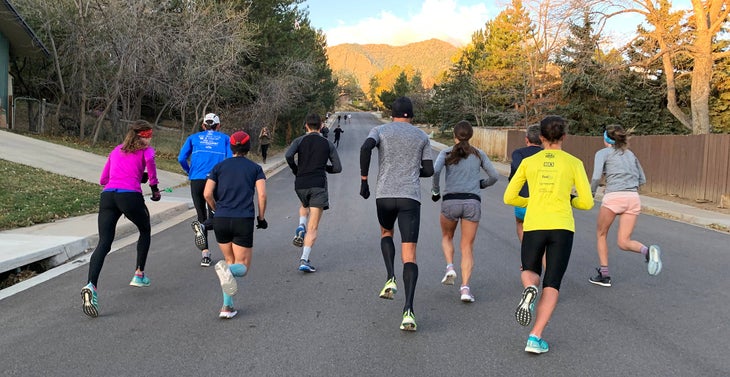The training that you’re able to do before a race dictates how well you will do in that race. Improve the training and you’ll almost certainly improve your race results.
Improved training usually means higher mileage, faster and longer workouts, and more consistent long runs. But to handle the volume and intensity of that pre-race training depends on what you do before the training begins, what you do in the off-season.
You need to “train for the training.” In other words, you need a season dedicated to improving your training—not just your race performances.
A good example is to think about the marathon. There is no “Couch to Marathon” training program, because marathon training requires a baseline of running fitness before a marathon plan is ever started (even programs called “couch to marathon” include a progression of fitness stages). You have to train to be ready to handle the volume of the marathon. Similarly, you have to train to be ready to handle more advanced training programs to excel at other distances.
Just like you have to learn how to read before you learn Shakespeare, you have to prepare for race-specific training by developing prerequisite skills. That foundational training includes mileage and workouts (what runners are most familiar with) but it also includes periodizing strength training so you’re lifting weights at an appropriate intensity.
Here are three elements of training to focus on during this off-season phase of running, where the priority is improving your capacity to handle a higher workload.

Prepare for Hard Running with Easy Running
You have to crawl before you can walk, and you have to run easy before you can run fast.
More running is the most effective way of preparing yourself for the harder training to come in the more race-specific block of training. That’s because higher mileage has a host of benefits:
- Increased running economy and efficiency
- More endurance through a higher aerobic capacity
- Injury prevention by adaptation to a higher workload
- Ability to run faster, for longer
Regardless of your goal race distance, gradually increasing your weekly mileage during the off-season will make any challenging workout more manageable during the competition phase of training.
Since training PR’s typically lead to race PR’s, focus on reaching a new weekly mileage PRs during the off-season. But don’t peak and fall off: Stay consistent with the mileage and in a few months, you’ll feel stronger and more capable.
Go Fast Sparingly
A small dose of speedwork during the offseason will prepare you for the longer, more challenging workouts in the future. It’s a mistake to ignore faster running for a long period of time during base or off-season training.
Strides
If you’re new to running fast or haven’t attempted any speed workouts in 1-2 months, it’s helpful to start with strides. These are 100-meter accelerations that have you start at a jog, build to about 95% of your maximum speed, and then coast to a stop. One stride should take about 20-25 seconds and are followed by a 1–2min walking or standing recovery interval.

Fartlek
Fartlek training is another option. Fartleks are time-based repetitions and they’re incredibly versatile, allowing you to vary the length of the repetition, its speed, and the recovery interval.
If you’ve been doing strides and gradually-increasing speed sessions, an example of an off-season fartlek workout might be 10×1-minute at 5k pace with a 2-minute jog recovery.
This session is acceptable during the off-season because the recovery is long compared to the repetition, so you’re getting a fuller recovery. And, at only one minute, the length of the rep isn’t so long as to create excessive fatigue. Finally, fartlek workouts are less exact than a track session so there’s less mental pressure to hit an exact split—that’s important during the offseason when the focus is not on exact performances.
Build Strong Armor
Strength training provides the armor that will protect you from the stress of hard running. And there’s no better time to start than the base phase of training.
Much like the running portion of your training during the offseason, strength training should follow similar principles:
- It’s preparatory in nature, helping you get ready for more challenging weightlifting during peak training
- It shouldn’t be too hard or demanding (lifting for power or lifting with heavy weights can come later)
- The priority should be on fundamental, compound, multi-joint exercises (like the deadlift, squat, and press)

Completing three sets of 10 reps of any lift with a weight that’s challenging but manageable for your abilities accomplishes these goals.
Spending 1-2 days in the gym during the offseason is an effective investment in injury prevention, helping you toughen connective tissues, bones, and muscles to withstand the rigors of distance running. Strength training also improves running economy and helps you race faster. It’s so important that you shouldn’t consider it cross-training—just part of the training that distance runners need to do to reach their potential.
Start your strength workouts during base training is also a smart idea as you’ll likely be too tired, sore, or unmotivated to add it during peak training. Begin the habit now so you’ll be more likely to follow through on a consistent strength training program.


